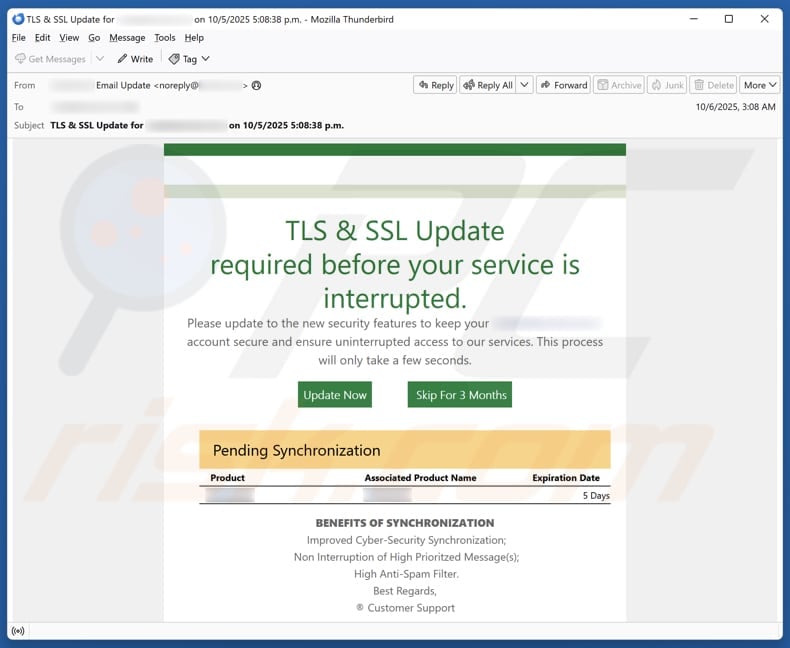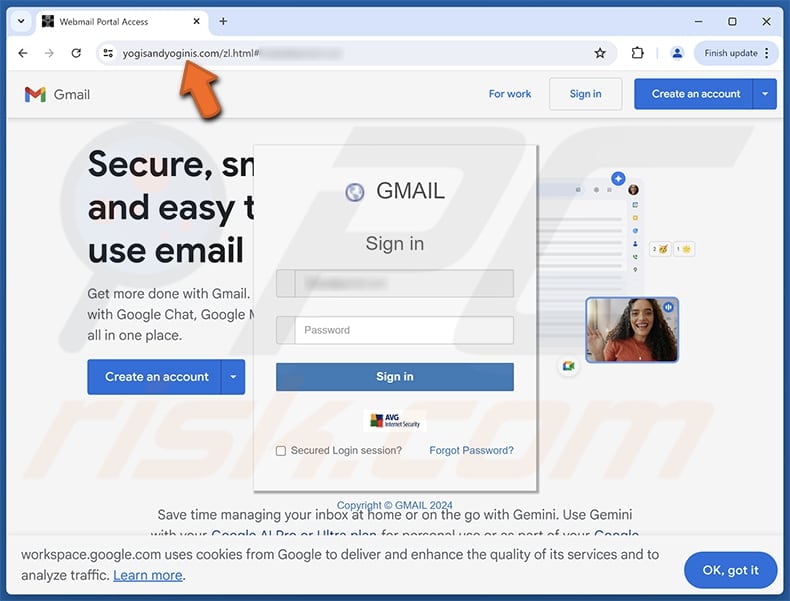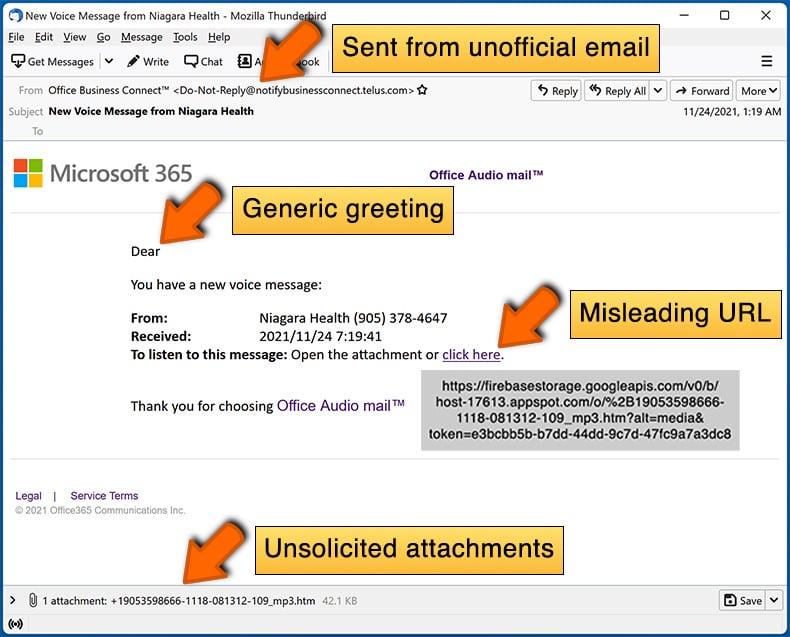How to identify scams like "TLS & SSL Update"
Phishing/ScamAlso Known As: TLS & SSL Update phishing email
Get free scan and check if your device is infected.
Remove it nowTo use full-featured product, you have to purchase a license for Combo Cleaner. Seven days free trial available. Combo Cleaner is owned and operated by RCS LT, the parent company of PCRisk.com.
What kind of scam is the fake "TLS & SSL Update"?
We have inspected the email and concluded that it is a phishing email. The scammers behind it aim to trick recipients into believing that they have received a message from their email service provider regarding new security features. The goal of this scam is to extract personal information from recipients.

More about the "TLS & SSL Update" scam email
This phishing email suggests that a TLS and SSL update is required for the recipient's account. It claims that the recipient must update to the new security features to keep the account secure and ensure uninterrupted access to services. It also implies that the service will be interrupted if the update is not completed.
The email provides links (labeled "Update Now" and "Skip For 3 Months") and provides benefits of the synchronization (such as improved cybersecurity, uninterrupted access to high-priority messages, and enhanced anti-spam filtering). Its goal is to lure recipients into a fake website.
This fraudulent page copies the appearance of the recipient's email service provider. For example, if the user has a Gmail account, the site replicates the Gmail sign-in page. The purpose of this fraudulent website is to steal login credentials from visitors.
When cybercriminals gain access to email accounts, they often use them to send phishing or scam messages to the account's contacts, attempt to reset passwords for other accounts, and collect sensitive information stored in emails. They may also try to use the stolen credentials on other platforms, such as social media or banking services.
In addition, stolen login details (and other harvested information) can be sold to third parties (e.g., other cybercriminals). For this reason, it is crucial to carefully review suspicious emails before clicking links, opening attachments, or providing information.
| Name | TLS & SSL Update Email Scam |
| Threat Type | Phishing, Scam, Social Engineering, Fraud |
| Fake Claim | Update required to avoid service interruption |
| Disguise | Message from the email service provider |
| Related Domain | yogisandyoginis[.]com |
| Detection Names (yogisandyoginis[.]com) | Criminal IP (Phishing), CyRadar (Malicious), ESET (Phishing), Seclookup (Malicious), Sophos (Phishing), Full List Of Detections (VirusTotal) |
| Symptoms | Unauthorized online purchases, changed online account passwords, identity theft, illegal access of the computer. |
| Distribution methods | Deceptive emails, rogue online pop-up ads, search engine poisoning techniques, misspelled domains. |
| Damage | Loss of sensitive private information, monetary loss, identity theft. |
| Malware Removal (Windows) |
To eliminate possible malware infections, scan your computer with legitimate antivirus software. Our security researchers recommend using Combo Cleaner. Download Combo CleanerTo use full-featured product, you have to purchase a license for Combo Cleaner. 7 days free trial available. Combo Cleaner is owned and operated by RCS LT, the parent company of PCRisk.com. |
Conclusion
This phishing email and its associated fake website are designed to steal login credentials. If successful, cybercriminals can access the victim’s accounts, spread scams to contacts, and misuse or sell sensitive information. Users should always verify emails and avoid clicking links or entering personal information on suspicious sites.
It is important to note that emails of this kind can be used to trick recipients into infecting their computers. Some examples of similar scams are "DHL Package Is Ready For Delivery", "Join Google Meet", and "Migration To New Email Interface".
How do spam campaigns infect computers?
It is common for malware to be delivered via email. The malicious software is often concealed in attachments, including Word or Excel documents, PDFs, script files, executables (.exe), or compressed archives such as ZIP or RAR files. Opening these attachments, or taking additional steps, like enabling macros, can activate the malware.
Deceptive emails may also contain links to fraudulent (or hacked) websites. Accessing these sites can automatically download malware or persuade the user to manually download and run harmful software.
How to avoid installation of malware?
Exercise caution when browsing potentially unsafe websites and avoid interacting with pop-ups, ads, or other content on such sites. Be careful with messages from unknown senders and never open unexpected attachments or click on links.
Only download software from trusted sources, such as official websites or reputable app stores, and do not allow untrusted sites to send notifications. Keep your operating system, applications, and antivirus software up to date, and perform regular security scans to stay protected.
Text presented in the "TLS & SSL Update" email letter:
Subject: TLS & SSL Update for ******** on 10/5/2025 5:08:38 p.m.
Renew your services today! | View this email online
TLS & SSL Update
required before your service is interrupted.Please update to the new security features to keep your (******** ) account secure and ensure uninterrupted access to our services. This process will only take a few seconds.
[Update Now] [Skip For 3 Months]
Pending Synchronization
Product Associated Product Name Expiration Date
******** ******** 5 DaysBENEFITS OF SYNCHRONIZATION
Improved Cyber-Security Synchronization;
Non Interruption of High Prioritzed Message(s);
High Anti-Spam Filter.
Best Regards,
® Customer SupportPlease do not reply to this email. Replying to this email will not secure your services. Please review our Privacy Policy and our Service Agreement and any applicable supplemental service agreements for additional terms and conditions.
©2025 All Rights Reserved.
Fake website used in this scam:

Instant automatic malware removal:
Manual threat removal might be a lengthy and complicated process that requires advanced IT skills. Combo Cleaner is a professional automatic malware removal tool that is recommended to get rid of malware. Download it by clicking the button below:
DOWNLOAD Combo CleanerBy downloading any software listed on this website you agree to our Privacy Policy and Terms of Use. To use full-featured product, you have to purchase a license for Combo Cleaner. 7 days free trial available. Combo Cleaner is owned and operated by RCS LT, the parent company of PCRisk.com.
Quick menu:
- What is TLS & SSL Update phishing email?
- Types of malicious emails.
- How to spot a malicious email?
- What to do if you fell for an email scam?
Types of malicious emails:
![]() Phishing Emails
Phishing Emails
Most commonly, cybercriminals use deceptive emails to trick Internet users into giving away their sensitive private information, for example, login information for various online services, email accounts, or online banking information.
Such attacks are called phishing. In a phishing attack, cybercriminals usually send an email message with some popular service logo (for example, Microsoft, DHL, Amazon, Netflix), create urgency (wrong shipping address, expired password, etc.), and place a link which they hope their potential victims will click on.
After clicking the link presented in such email message, victims are redirected to a fake website that looks identical or extremely similar to the original one. Victims are then asked to enter their password, credit card details, or some other information that gets stolen by cybercriminals.
![]() Emails with Malicious Attachments
Emails with Malicious Attachments
Another popular attack vector is email spam with malicious attachments that infect users' computers with malware. Malicious attachments usually carry trojans that are capable of stealing passwords, banking information, and other sensitive information.
In such attacks, cybercriminals' main goal is to trick their potential victims into opening an infected email attachment. To achieve this goal, email messages usually talk about recently received invoices, faxes, or voice messages.
If a potential victim falls for the lure and opens the attachment, their computers get infected, and cybercriminals can collect a lot of sensitive information.
While it's a more complicated method to steal personal information (spam filters and antivirus programs usually detect such attempts), if successful, cybercriminals can get a much wider array of data and can collect information for a long period of time.
![]() Sextortion Emails
Sextortion Emails
This is a type of phishing. In this case, users receive an email claiming that a cybercriminal could access the webcam of the potential victim and has a video recording of one's masturbation.
To get rid of the video, victims are asked to pay a ransom (usually using Bitcoin or another cryptocurrency). Nevertheless, all of these claims are false - users who receive such emails should ignore and delete them.
How to spot a malicious email?
While cyber criminals try to make their lure emails look trustworthy, here are some things that you should look for when trying to spot a phishing email:
- Check the sender's ("from") email address: Hover your mouse over the "from" address and check if it's legitimate. For example, if you received an email from Microsoft, be sure to check if the email address is @microsoft.com and not something suspicious like @m1crosoft.com, @microsfot.com, @account-security-noreply.com, etc.
- Check for generic greetings: If the greeting in the email is "Dear user", "Dear @youremail.com", "Dear valued customer", this should raise suspiciousness. Most commonly, companies call you by your name. Lack of this information could signal a phishing attempt.
- Check the links in the email: Hover your mouse over the link presented in the email, if the link that appears seems suspicious, don't click it. For example, if you received an email from Microsoft and the link in the email shows that it will go to firebasestorage.googleapis.com/v0... you shouldn't trust it. It's best not to click any links in the emails but to visit the company website that sent you the email in the first place.
- Don't blindly trust email attachments: Most commonly, legitimate companies will ask you to log in to their website and to view any documents there; if you received an email with an attachment, it's a good idea to scan it with an antivirus application. Infected email attachments are a common attack vector used by cybercriminals.
To minimise the risk of opening phishing and malicious emails we recommend using Combo Cleaner Antivirus for Windows.
Example of a spam email:

What to do if you fell for an email scam?
- If you clicked on a link in a phishing email and entered your password - be sure to change your password as soon as possible. Usually, cybercriminals collect stolen credentials and then sell them to other groups that use them for malicious purposes. If you change your password in a timely manner, there's a chance that criminals won't have enough time to do any damage.
- If you entered your credit card information - contact your bank as soon as possible and explain the situation. There's a good chance that you will need to cancel your compromised credit card and get a new one.
- If you see any signs of identity theft - you should immediately contact the Federal Trade Commission. This institution will collect information about your situation and create a personal recovery plan.
- If you opened a malicious attachment - your computer is probably infected, you should scan it with a reputable antivirus application. For this purpose, we recommend using Combo Cleaner Antivirus for Windows.
- Help other Internet users - report phishing emails to Anti-Phishing Working Group, FBI’s Internet Crime Complaint Center, National Fraud Information Center and U.S. Department of Justice.
Frequently Asked Questions (FAQ)
Why did I receive this email?
Scammers often collect email addresses from leaks or fake sites and send the same message to many people, rather than targeting someone specifically.
I have provided my personal information when tricked by this email, what should I do?
Change all compromised passwords if your login details have been exposed. If financial or personal identification information is affected, report the incident to your bank and local authorities.
I have downloaded and opened a malicious file attached to an email, is my computer infected?
Your computer could be infected, particularly if the downloaded file is an executable (.exe). Other malicious files, like documents, often need extra actions (such as enabling macros) to trigger the malware.
I have read the email but did not open the attachment, is my computer infected?
Opening an email is harmless. A device becomes at risk only when the recipient clicks on harmful links or opens infected attachments.
Will Combo Cleaner remove malware infections that were present in email attachment?
Combo Cleaner can detect and remove most types of known malware. Since advanced malware may be deeply hidden in the system, performing a full system scan is strongly advised.
Share:

Tomas Meskauskas
Expert security researcher, professional malware analyst
I am passionate about computer security and technology. I have an experience of over 10 years working in various companies related to computer technical issue solving and Internet security. I have been working as an author and editor for pcrisk.com since 2010. Follow me on Twitter and LinkedIn to stay informed about the latest online security threats.
PCrisk security portal is brought by a company RCS LT.
Joined forces of security researchers help educate computer users about the latest online security threats. More information about the company RCS LT.
Our malware removal guides are free. However, if you want to support us you can send us a donation.
DonatePCrisk security portal is brought by a company RCS LT.
Joined forces of security researchers help educate computer users about the latest online security threats. More information about the company RCS LT.
Our malware removal guides are free. However, if you want to support us you can send us a donation.
Donate
▼ Show Discussion